Health Literacy Statistics: Health literacy, a critical component of individual and public health, refers to the ability of individuals to understand, access, evaluate, and use health information to make informed decisions about their well-being.
It plays a pivotal role in empowering people to take control of their health and navigate complex healthcare systems.
Understanding health literacy is essential for crafting effective healthcare policies, promoting preventive measures, and addressing health disparities.
This introduction sets the stage for a deeper exploration of health literacy statistics, which encompass a wide range of data regarding the prevalence and implications of health literacy, as well as the efforts being made to improve it on a global scale.
Table of Contents
- Editor’s Choice
- Health Literacy Statistics Worldwide
- Gender Health Literacy Statistics
- Race/Ethnicity Health Literacy Statistics
- Health Literacy Statistics by Level of Education
- Health Literacy Statistics by Age
- Statistics by Health Insurance Type
- Health Literacy Statistics by Country
- Recent Developments
- Wrap Up
- FAQs
Editor’s Choice
- The Healthcare IT market size is expected to be worth around USD 1728 Bn by 2032
- According to a report by UNESCO, countries in South and South-West Asia have the highest number of illiterate adults in the world, estimated at 388 million.
- Approximately 36% of adult Americans possess only basic or below basic health literacy skills.
- Only 12% of Americans are considered proficient in their health literacy skills.
- Health literacy levels in China increased from 6.48% of the population in 2008 to 23.15% in 2020.
- A recent study analyzing global health literacy research from 1995 to 2020 identified the United States, Australia, and the United Kingdom as major contributors to the international collaboration network on health literacy.
- Mental health has been the most active research field in recent years in the context of health literacy.
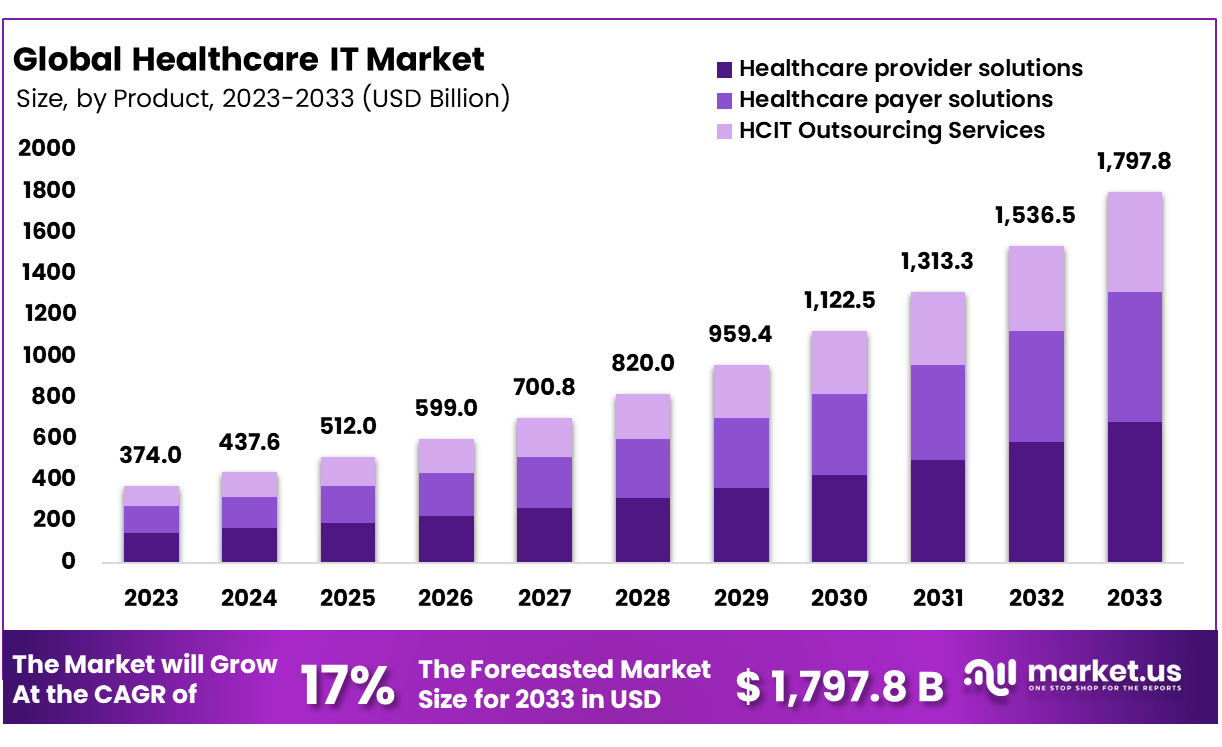
Health Literacy Statistics Worldwide
- Only 12% of adults in the United States have proficient health literacy, as reported by the National Assessment of Adult Literacy (NAAL). In other words, nearly nine out of ten adults in the United States may lack the skills needed to effectively manage their health and healthcare.
- More than 90 million people in the United States struggle with understanding and using health information, highlighting a significant health literacy challenge in the country.
- Only 12% of the population demonstrates proficient health literacy, indicating a high level of competence in understanding and applying health information.
- The majority of the population, comprising 53%, falls into the intermediate health literacy category, signifying a moderate ability to comprehend and utilize health-related information.
- About 21% of the population possesses basic health literacy skills, suggesting a limited understanding of health information, which may require simplification and support.
- A notable 14% of the population falls into the below basic health literacy level, indicating a significant challenge in comprehending and utilizing health-related information, necessitating substantial assistance and education.
(Source: American Health Literacy)
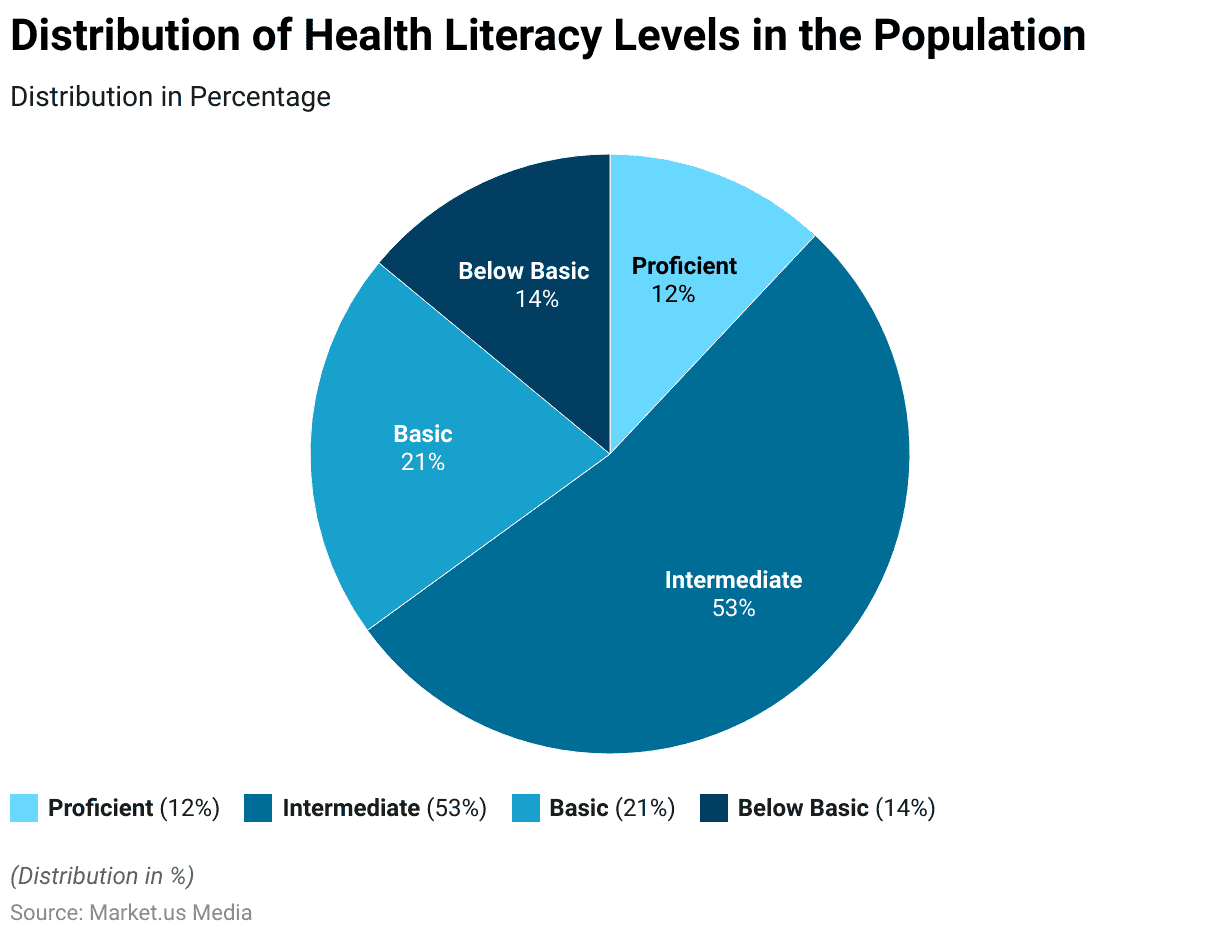
Gender Health Literacy Statistics
- According to a 2013 report by the Centers for Disease Control and Prevention (CDC), health literacy rates in the United States are higher among women than men.
- Health literacy rates by gender:
- Women: 78.1%
- Men: 67.8%
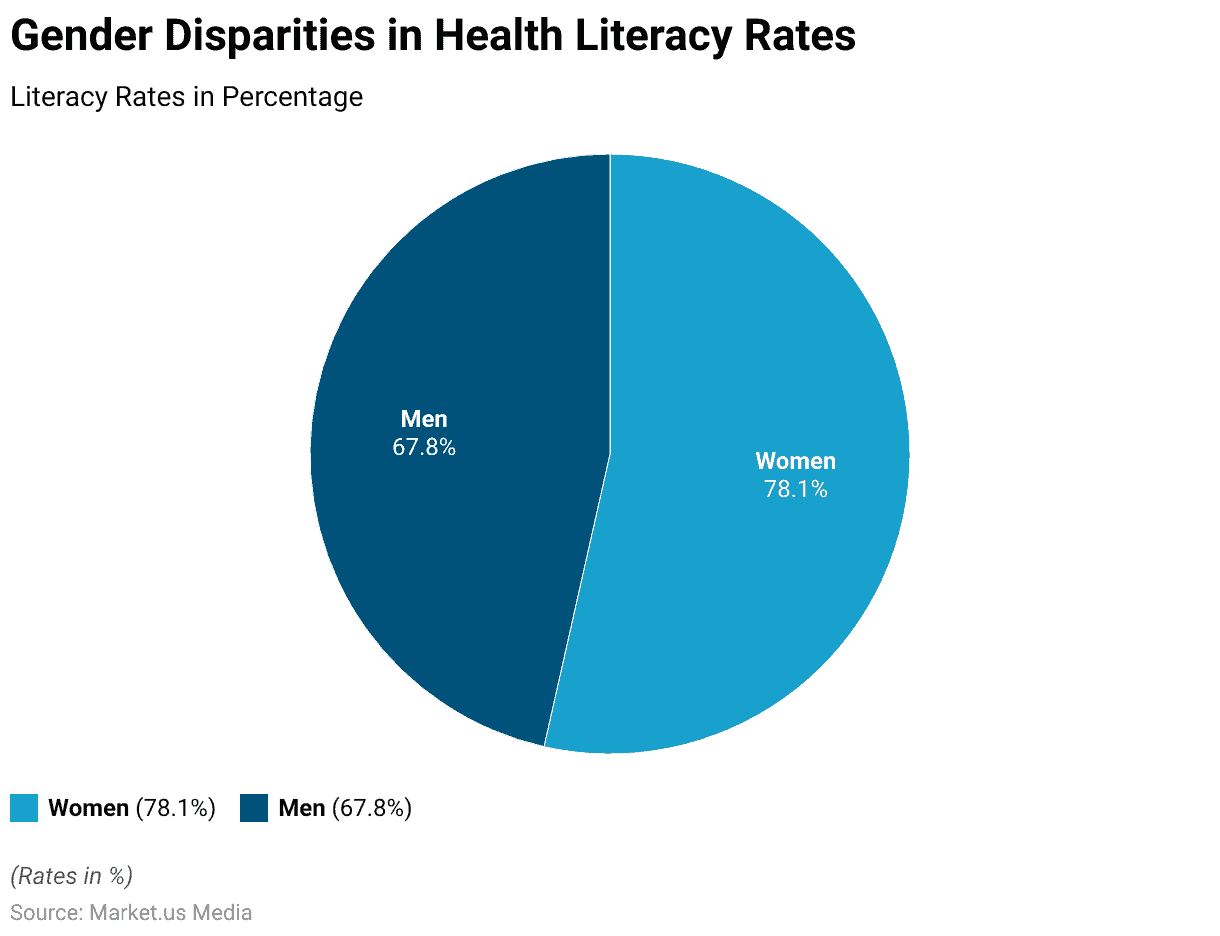
Race/Ethnicity Health Literacy Statistics
- Racial and ethnic minorities, on average, had lower health literacy scores than White adults.
- In comparison to the 9% of White adults, 24% of Black adults, 41% of Hispanic adults, 13% of Asian adults, and 25% of American Indian and Native Alaskan adults scored at the “Below Basic” level in health literacy.
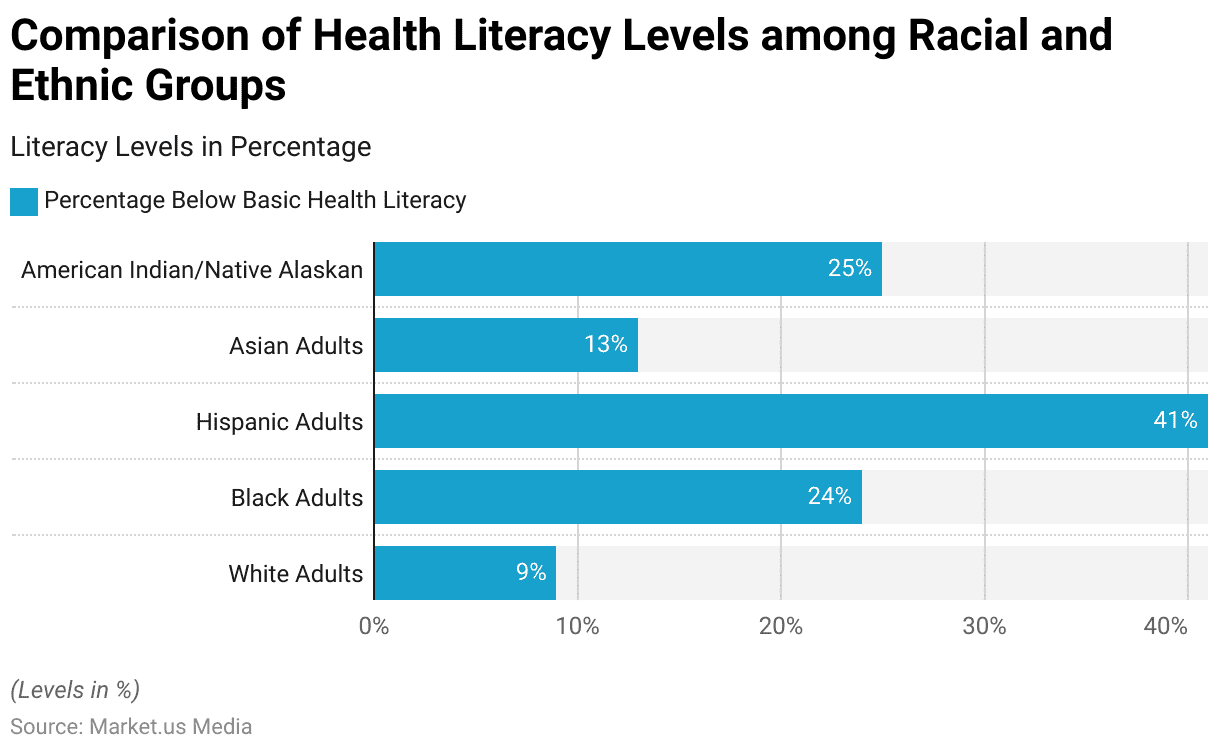
Health Literacy Statistics by Level of Education
- Among adults with less than a high school education, 53% have “Below Basic” health literacy, while 30% have “Basic” health literacy, 10% have “Intermediate” health literacy, and 7% have “Proficient” health literacy.
- High school graduates and those with a GED have 23% with “Below Basic” health literacy, 40% with “Basic” health literacy, 27% with “Intermediate” health literacy, and 10% with “Proficient” health literacy.
- Adults with some college attendance or a degree beyond high school exhibit 19% “Below Basic” health literacy, 39% “Basic” health literacy, 23% “Intermediate” health literacy, and 19% “Proficient” health literacy.
- Those with a Bachelor’s degree or higher have the lowest percentage of “Below Basic” health literacy at 3%, with 9% having “Basic” health literacy, 29% having “Intermediate” health literacy, and 59% having “Proficient” health literacy.
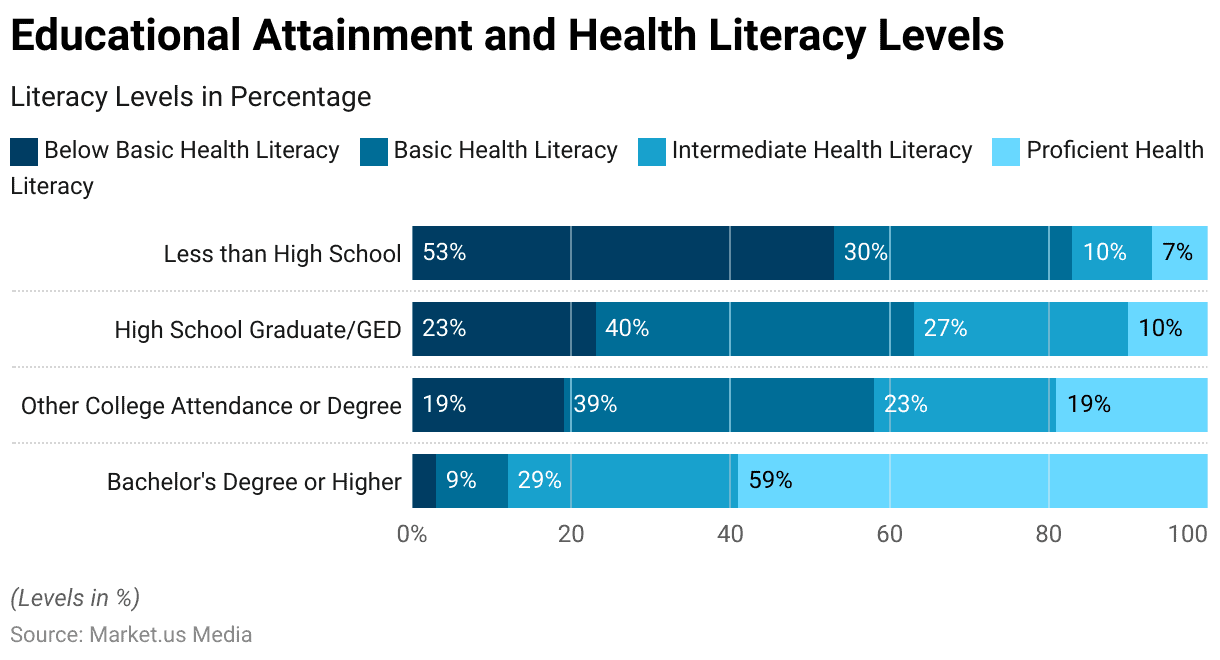
Health Literacy Statistics by Age
- In the age group 16-49, 12% of individuals have “Below Basic” health literacy, 44% have “Basic” health literacy, 29% have “Intermediate” health literacy, and 15% have “Proficient” health literacy.
- For the age group 50-64, 28% of individuals have “Below Basic” health literacy, 44% have “Basic” health literacy, 19% have “Intermediate” health literacy, and 9% have “Proficient” health literacy.
- Among those aged 65-75, 39% have “Below Basic” health literacy, 31% have “Basic” health literacy, 16% have “Intermediate” health literacy, and 14% have “Proficient” health literacy.
- In the age group over 75, 56% of individuals have “Below Basic” health literacy, 22% have “Basic” health literacy, 11% have “Intermediate” health literacy, and 11% have “Proficient” health literacy.
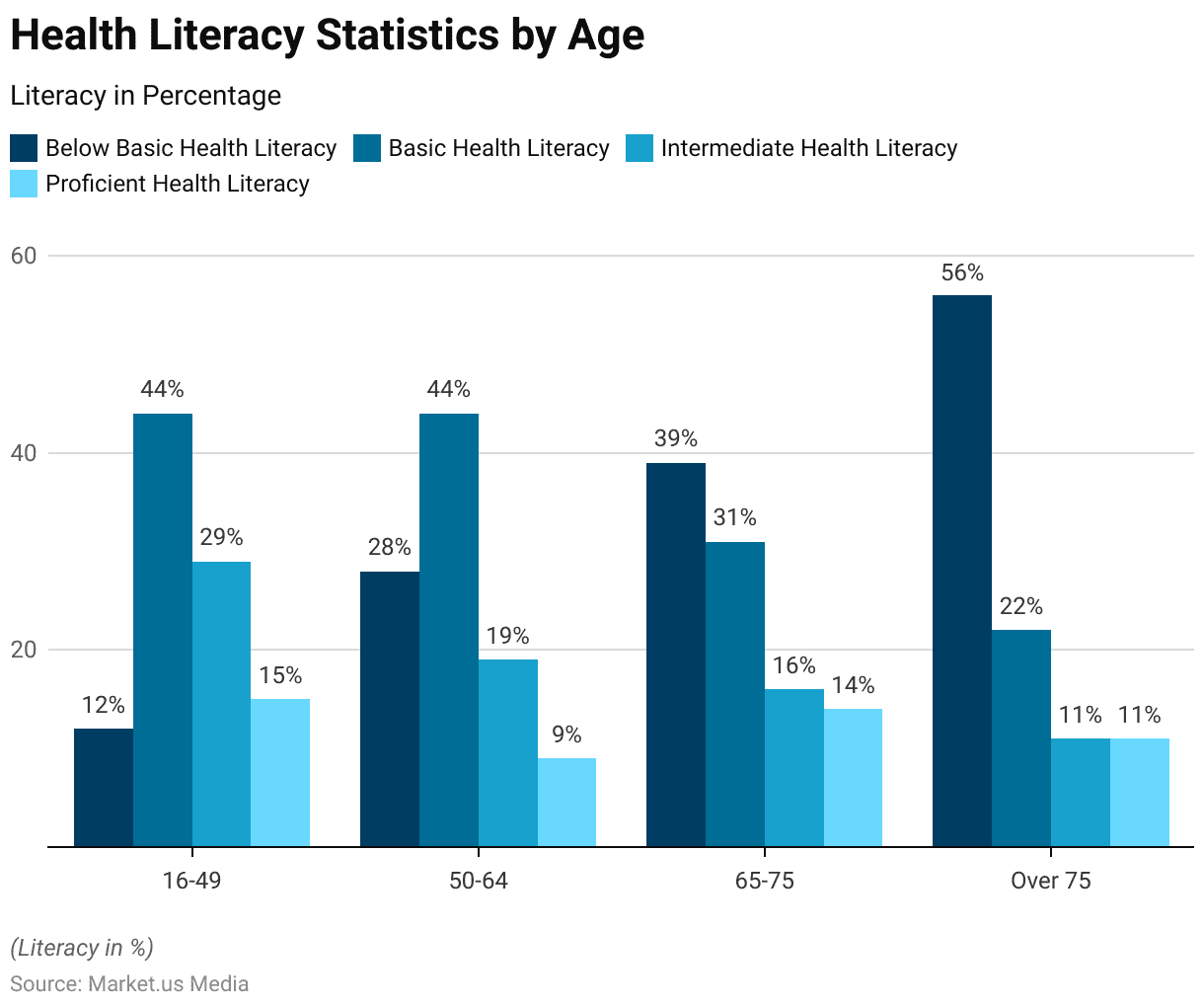
Statistics by Health Insurance Type
- The majority of adults (62%) have employer-provided health insurance, and a significant percentage of them (56%) have “Proficient” health literacy. This suggests that individuals with employer-provided insurance tend to have higher health literacy levels, with only 14% falling into the “Below Basic” category.
- While a smaller percentage of adults (21%) have military health insurance, a notable 40% of them have “Below Basic” health literacy. This indicates a potential need for targeted health literacy interventions within this group.
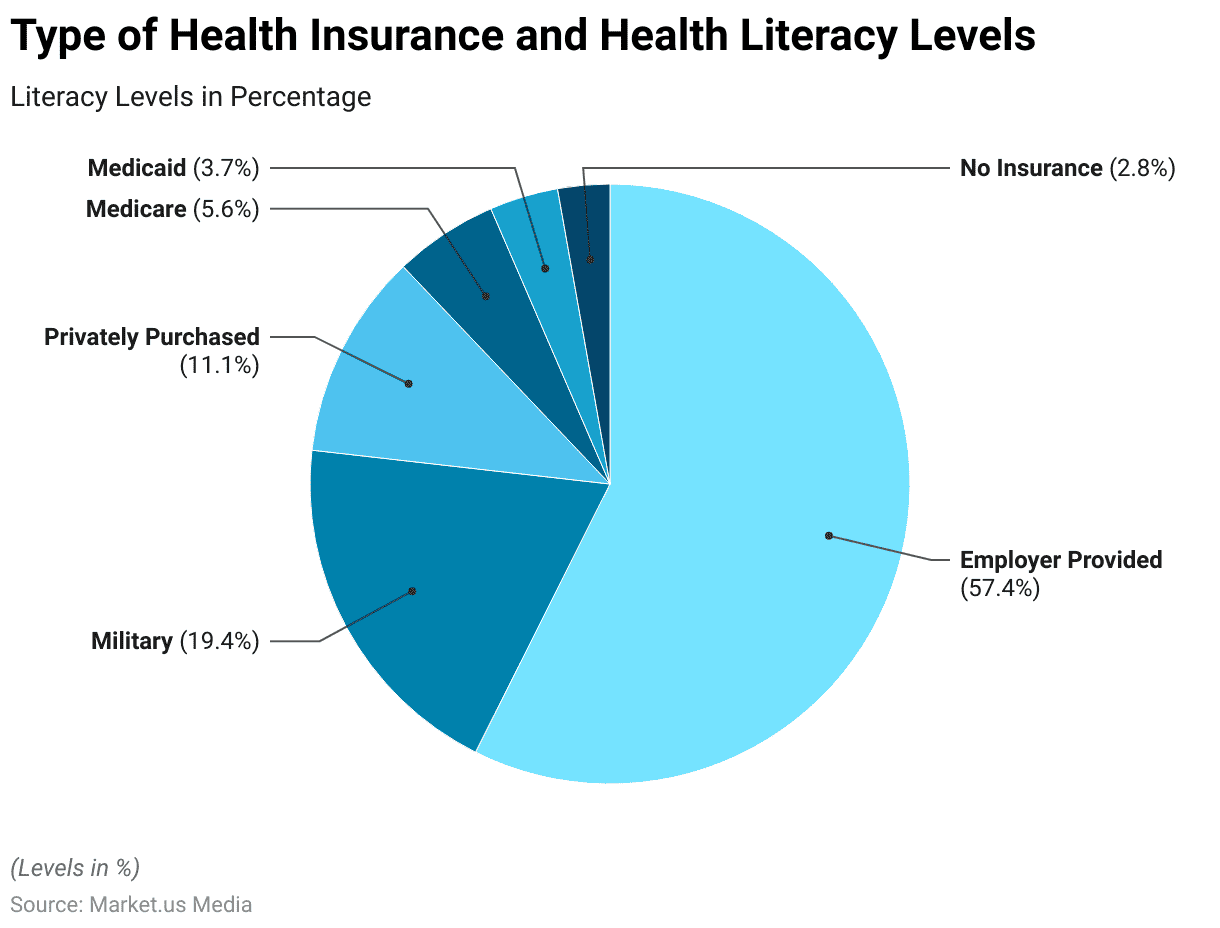
Health Literacy Statistics by Country
- A study conducted at a private dental hospital in Bangalore to evaluate the health literacy of adult patients seeking oral health care revealed that approximately 60.4% of the participants exhibited low health literacy, 29.4% demonstrated average health literacy, and only 10.2% displayed a high level of health literacy.
- In 2022, the health literacy rate among the Chinese population increased by approximately 2.4% points from the previous year, reaching nearly 28%, as reported by the National Health Commission. This means that approximately 28 out of every 100 people in China have acquired fundamental health knowledge.
- Roughly 36% of adults in the United States possess health literacy skills that are at the basic or below basic level.
- About 32% of individuals in Finland have a high literacy rate, 51% have a medium literacy rate, and 17% have a low literacy rate.
- Approximately 60% of individuals exhibited insufficient functional health literacy, while 27% demonstrated insufficient comprehensive health literacy in Sweden.
- In the international report, the findings from Norway indicate that 38% of the population exhibits a concerning level of health literacy, with an additional 8% displaying an insufficient level, resulting in a combined 46% having restricted general health literacy.
- According to the 2020 survey data, there was a 10% rise in the proportion of people with limited health literacy, resulting in approximately 64.2% of the population in Germany having limited health literacy.
Recent Developments
Acquisitions and Mergers:
- Acquisition of a health education platform by a healthcare technology company in September 2023, expanding their offerings to include interactive health literacy resources.
- The merger between two health literacy organizations in December 2023, combined their expertise to address literacy disparities and improve patient understanding of healthcare information.
New Product Launches:
- Introduction of mobile health apps focused on health literacy and patient education by digital health startups in January 2024, providing accessible information on medical conditions and treatment options.
- Launch of online health literacy courses for healthcare professionals and patients by educational institutions and medical associations in March 2024, enhancing literacy skills and promoting informed decision-making.
Funding Rounds:
- Series B funding round for a health literacy research institute in February 2024, raising $30 million to support studies on effective health communication strategies and interventions.
- Seed funding for a health literacy nonprofit organization in April 2024, securing $5 million to develop community-based programs and resources for underserved populations.
Partnerships and Collaborations:
- Collaboration between a health insurance provider and a digital health company in November 2023 to integrate health literacy tools into the insurer’s member portal, empowering patients to make informed healthcare choices.
- The partnership between a hospital system and a local library in March 2024 to establish health literacy kiosks and provide access to reliable health information and resources.
Technology Integration:
- Integration of artificial intelligence (AI) and natural language processing (NLP) technologies into health literacy tools to personalize content and tailor information to individual patient needs.
- Development of multimedia health education materials, including videos, infographics, and interactive modules, to enhance engagement and comprehension among diverse audiences.
Investment Landscape:
- Venture capital investments in health literacy startups totaled $2.8 billion in 2023, with a focus on companies offering innovative solutions for patient education and engagement.
- Strategic partnerships and collaborations between healthcare organizations, technology companies, and educational institutions accounted for 55% of total investment activity in the health literacy market in 2023, reflecting industry-wide efforts to address literacy barriers and promote health equity.
Wrap Up
Health Literacy Statistics- In conclusion, health literacy is a crucial skill that empowers individuals to make informed decisions about their health and well-being.
It involves the ability to access, understand, and use health information effectively. Improving health literacy not only leads to better health outcomes but also reduces healthcare disparities and lowers healthcare costs.
It’s essential for individuals to continuously enhance their health literacy, and for healthcare providers and organizations to communicate information in a clear and accessible manner. Ultimately, a more health-literate society leads to improved overall public health and quality of life.
FAQs
Health literacy refers to the ability of an individual to understand, access, evaluate, and apply health-related information to make informed decisions about their health.
Health literacy is crucial for individuals to make informed healthcare decisions, understand medical instructions, and navigate the healthcare system effectively. It can significantly impact health outcomes and healthcare costs.
The most common measures of health literacy include the Test of Functional Health Literacy in Adults (TOFHLA), the Rapid Estimate of Adult Literacy in Medicine (REALM), and the Newest Vital Sign (NVS) test.
Health literacy statistics provide insights into the level of health literacy in a population or specific groups. These statistics can help identify areas where improvement is needed, evaluate the effectiveness of health education programs, and inform healthcare policies.
Discuss your needs with our analyst
Please share your requirements with more details so our analyst can check if they can solve your problem(s)



